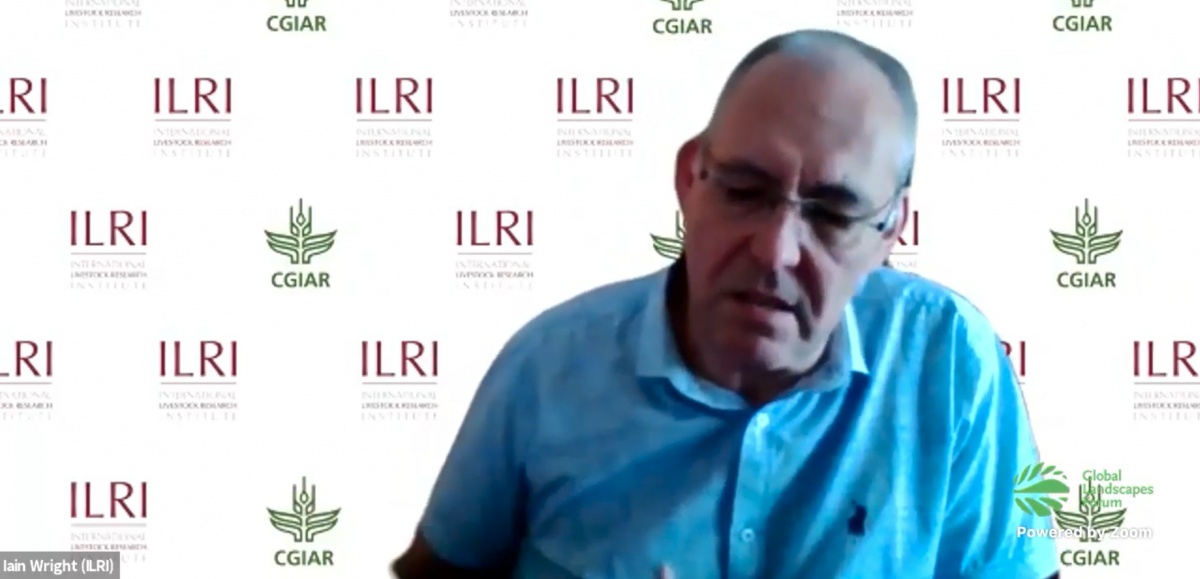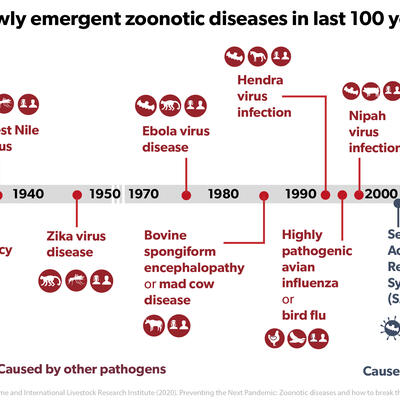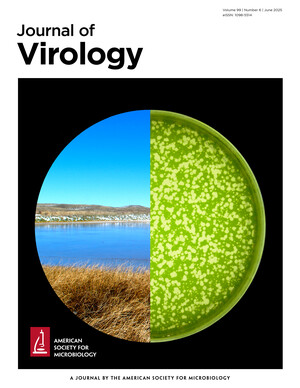
Does COVID-19 offer opportunities for progressing One Health?
As COVID-19 continues to wreck havoc on lives, economies and food systems, the world has proved to be sorely under-prepared. This despite past warnings that zoonotic diseases, transmitted from animals to humans, could represent a significant risk to global health and prosperity. If any silver lining is to be found in this crisis, it might be that it offers opportunities to accelerate progress towards a ‘One Health’ approach.
That was the conclusion of experts from the International Livestock Research Institute (ILRI), the United Nations Environment Programme (UNEP) and the Ministry of Health in Kenya, who came together to discuss how to ‘build back better’ in the wake of the coronavirus disease 2019 (COVID-19) pandemic. Their exchange, which took place on 4 June, 2020, as part of the Global Landscapes Forum, highlighted the ‘One Health’ approach as the solution for healthy landscapes, people, animals and wildlife.
‘The penny is beginning to drop that animal, human and environment health are intimately connected. One Health ideas are becoming much more prominent, including in political dialogue. That, I think, is new in this COVID-19 pandemic’, said Iain Wright, deputy director general of ILRI.
Wright went on to say that an opportunity exists for the research community to respond to governments’ questions and that while science organizations such as ILRI certainly do not have all the answers, they do have evidence of some of the best ways to move ahead.

Iain Wright is the deputy director general of ILRI. Photo: GLF.
Building alliances and partnerships, learning from local efforts, and educating youth and consumers were among the opportunities highlighted by the session’s speakers. However, the discussion opened with four quick presentations explaining how we ended up with a zoonotic disease outbreak that managed to grow into a global pandemic.
- View the session in full: https://youtu.be/DpNCH3U0jl0
How did we get here?
‘Zoonotic diseases come from a deadly intersection of human, animal and environment health’, said Delia Grace, a veterinary epidemiologist and food safety expert working jointly for ILRI and the Natural Resources Institute. ‘Humans make up 36% of the biomass of all mammals, livestock 60% and wild mammals just 4%.’
Grace explained that as much as 75% of new human diseases come from animals, and while most of them originate from wildlife, domestic animals are also important in disease transmission—as the origins, amplifiers or bridges of pathogens.
What’s more, humans have during the past century found themselves in much closer proximity with wildlife, explained Johannes Refisch, UNEP wildlife expert. Growing human populations have altered landscapes with their settlements, agriculture, logging and extractive industries, causing habitat and biodiversity losses. This has created opportunities for pathogens to pass between animals and people, as the natural buffers between them have disappeared. Refisch said, for example, that proximity to different species in traditional markets or consumption of wild animals can pass disease from animals to humans.
Doreen Lynn Robinson, UNEP’s chief for wildlife, conceded the challenges already listed by her colleagues and spotlighted possible solutions. Speaking specifically to food supply chains, she said that while many have called to cancel traditional (so-called ‘wet’) markets, where live animals are sometimes sold, hundreds of millions of people depend on these markets for food and income. Improving sanitation and monitoring of such markets is the way to prevent zoonotic diseases from emerging in them, she said.
Speaking to other contributing causes, including land-use change, extractive industries, increased travel and accelerated climate change, Robinson said: ‘If we address these root causes, many of which are tied to protecting planetary health, we will be improving our options for human well-being.’
But if One Health is the solution to these challenges, how can we implement the approach? Bernard Bett, a veterinary epidemiologist at ILRI and leader of a new One Health Centre based at ILRI, said that developing and implementing One Health solutions takes time. However, he said, these ideas are not new to most pastoralists:
‘When African herders come down with brucellosis [a highly infectious zoonotic disease], they go back home and screen their animals to stop further disease transmission.’
Considering how to achieve traction for One Health at scale, Bett concluded that One Health solutions tend to emerge when stakeholders from different disciplines find common ground around a ‘felt need’ and put their joint expertise on the table.
What can be done?
COVID-19 has certainly spurred an enormous ‘felt need’ among global actors, and decision-makers are now looking for knowledge, experience and lessons on how to prevent future zoonotic disease outbreaks from becoming pandemics. A policy panel comprising Hadley Matendechero Sultani, head of the division of vector-borne and neglected tropical diseases of the Ministry of Health in Kenya; Susan Gardner, director of UNEP’s ecosystems division, and Iain Wright, ILRI deputy director general, provided useful guidance.

Hadley Matendechero Sultani is the head of the division of vector-borne and neglected tropical diseases of the Ministry of Health in Kenya. Photo: GLF.
Sultani shared that Kenya’s Ministry of Health is part of an inter-ministerial working group on zoonotic disease management. He explained that in Kenya, efforts to monitor disease outbreaks do and should transcend regional and national boundaries, particularly as some pastoralists migrate across border regions with their livestock. Sultani added that creating a space where relevant actors can comfortably work together has been a top priority. This echoed experiences from the ground shared by Bett, who said that wildlife, livestock and medical experts in the country have been collaborating—across their different disciplines—to prevent the spread of Rift Valley Fever, another deadly zoonotic disease.
UNEP’s Susan Gardner spoke to opportunities at the global scale. Gardner said that while there is a risk of backsliding on environmental progress and commitments in the COVID-19 response phase, ‘We must emphasize how environment health undergirds human health and prosperity. We have the roadmaps already. Now we need to provide incentives and to implement.’
Gardner also highlighted the role of youth, saying that with a billion children and youth out of school, we have an opportunity to change curricula, such as by incorporating UNEP’s Earth School program, to spur behaviour change in future generations. Finally, she recommended that consumers get access to information that makes the impact of their choices clear, so that their behaviour too can change in favour of more sustainable interactions between the environment, animals and humans.
What’s next?
More than 200 people from all over the world—including Brazil, Burkina Faso, Colombia, India, Italy, Kenya, the Netherlands, the Philippines, Singapore and the UK—attended this ILRI-UNEP virtual session, and the questions they posed provide ways forward for scaling the One Health approach.
Several questions centred on whether our food systems are broken: What are some of the lessons emerging from this pandemic that can help us reshape how we produce, consume and protect our food?
Our food systems are doing a good job in producing food, answered ILRI’s Delia Grace, but they are doing a bad job in managing the externalities of that production, such as disease, stunting, obesity and environmental encroachment. ILRI’s Wright added that getting rid of livestock is not the solution to prevent the next pandemic. Some two billion depend on livestock for their livelihoods, he noted, and farm animals are critically important also for the nutrition of people living in poverty.
Asked about lessons for future efforts, Sultani, of the Ministry of Health in Kenya, shared four top recommendations: First to strengthen monitoring and surveillance systems, and second, fortifying existing interventions to ensure a comprehensive response to any disease outbreak. Sultani added strong coordination and partnerships to the list of recommendations, and finally said that preventing future pandemics will require being able to raise resources and developing robust plans that are costed efficiently. ‘We're looking at how to stretch every shilling to the max’, he noted.
The session ended with input from the virtual participants. Asked about their top take-aways, attendees provided a wide range of reflections that included the complexity as well as importance of implementing One Health; how intensive agriculture is part of the problem, but also the solution; how trying to eliminate the source of disease—such as bat colonies—might actually encourage greater spread of disease; how multi-disciplinary and multi-sector collaboration at multiple levels is essential; and how greater communication between ecologists, human health scientists, animal health scientists and local community members is of utmost importance.
Despite these challenges, one participant’s response poignantly underscored why joint efforts must continue: ‘We need to get One Health to really work this time...’
To guide governments and others in how to implement One Health, ILRI, UNEP and other partners are producing a rapid assessment report, to be published in July. This policy-friendly document is likely to serve as an essential reference for work to employ One Health solutions to prevent future pandemics and to ‘build back better’.
- Explore the ILRI-UNEP ‘build back better’ Twitter Moment


















